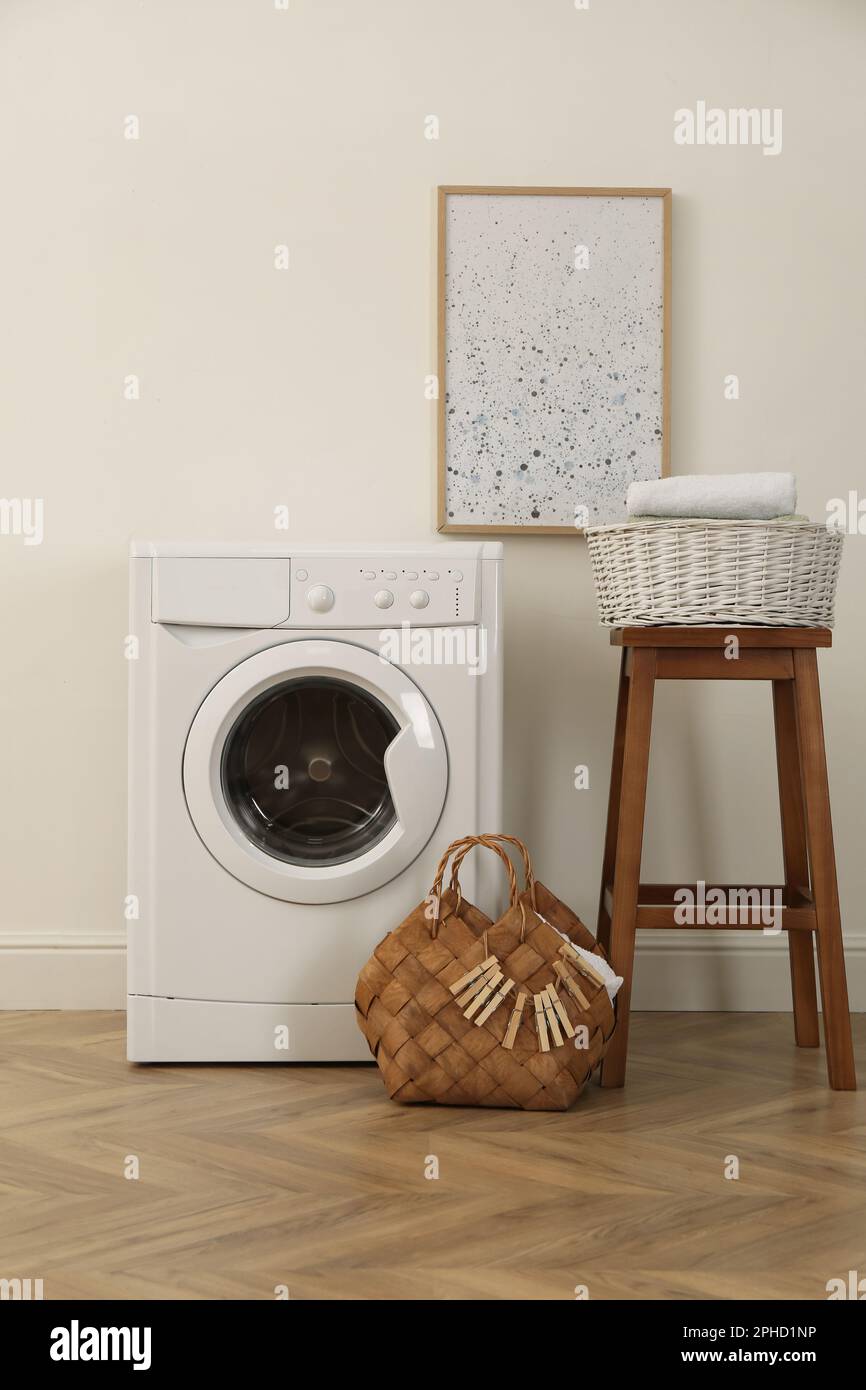You’ve finally found the perfect apartment, with gleaming hardwood floors and a spacious laundry area. But then you see it – a washing machine is about to be installed, right on top of that beautiful wood. A wave of apprehension washes over you. Is this a good idea? Will the constant vibrations and weight of the machine damage the floor? The answer, like most things in life, is not a simple yes or no. It depends on a few factors, and understanding those factors will help you make the right choice for your home.

Image: www.alamy.com
This guide will explore the pros and cons of putting a washing machine on a wooden floor, providing insights on how to mitigate risks and ensure the longevity of your floors and your appliance. We’ll delve into the science behind vibrations and weight distribution, examine different types of wooden floors, and discuss practical solutions for protecting your investment.
Understanding the Risks:
The key concern with placing a washing machine on a wooden floor is the potential for damage caused by vibrations and weight.
1. Vibrations:
Washing machines, particularly top-loading models, are notorious for generating vibrations during the spin cycle. These vibrations can transfer to the floor, causing movement and potentially loosening floorboards or even cracking the surface over time.
2. Weight:
A standard washing machine weighs approximately 150-200 pounds, which can put a significant strain on the underlying structure of a wooden floor. This weight load, coupled with the added vibrations, can lead to sagging and structural weakening, particularly in older or poorly constructed floors.

Image: www.plbg.com
Factors to Consider:
Before you make a decision, several factors need to be taken into account.
1. Type of Wooden Floor:
- Solid Hardwood Floors: These floors, made from solid pieces of wood, are generally thicker and sturdier than engineered floors. They are less likely to be affected by vibrations, but still require proper support.
- Engineered Hardwood Floors: These floors are made from layers of wood veneer, plywood, or other materials, making them more susceptible to damage from vibrations.
- Laminate Flooring: Laminate floors are designed to mimic the look of hardwood but are generally the least durable of all types. They are more prone to scratching and damage from heavy objects and vibrations.
2. Age and Condition of the Floor:
Older floors, especially those that weren’t properly installed or have structural issues, are more vulnerable to damage. Inspection by a qualified contractor is recommended, particularly if the floor is showing signs of warping, creaking, or instability.
3. Installation and Support:
A properly installed floor with adequate support will better withstand the weight and vibrations of a washing machine. Ensure the subfloor is solid and level, and consider using a plywood subfloor for additional stability.
Prevention is Key:
If you are determined to put your washing machine on a wooden floor, there are several preventive measures you can take to minimize the risk of damage.
1. Vibration Dampening Mat:
Investing in a vibration dampening mat, specifically designed for washing machines, can significantly reduce the amount of vibrations transferred to the floor. These mats are typically made from rubber or foam and act as a shock absorber. To maximize effectiveness, use a mat that covers the entire footprint of the washing machine.
2. Support Frame:
For added protection, consider using a support frame specifically designed for heavy appliances. These frames are typically made of sturdy steel and distribute the weight of the machine over a wider area, reducing the stress on the floor.
3. Leveling:
Ensure your washing machine is perfectly level. An unbalanced appliance will generate more vibrations, increasing the risk of damage. Use shims or leveling feet to adjust the appliance to the correct height and ensure stability.
4. Maintenance:
Regular maintenance is crucial! Keep your washing machine in good working order and address any issues promptly. A properly maintained machine will run smoother and generate less vibrations.
Alternatives to Consider:
If you’re still concerned about potential damage, consider these alternative solutions:
1. Designated Laundry Area:
If your home has a designated laundry room with a dedicated concrete floor, this is often the ideal solution. A concrete floor provides a solid and stable base that can easily handle the weight and vibrations of a washing machine.
2. Washing Machine Stand:
A washing machine stand can provide a stable base for your machine and help distribute the weight evenly. These stands are typically made from metal or heavy-duty plastic and raise the appliance off the ground, improving ventilation and making it easier to clean underneath.
3. Floor Reinforcement:
If you’re not comfortable with the risk, you can consider reinforcing your wooden floor. This involves adding structural support underneath, such as beams or joists, to increase the floor’s load-bearing capacity. Consult with a qualified contractor to assess the feasibility and cost of this option.
Can You Put A Washing Machine On A Wooden Floor
Conclusion:
Deciding whether or not to place a washing machine on a wooden floor is a personal decision based on your specific situation. By carefully assessing the factors involved, weighing the risks, and exploring preventative measures, you can make an informed choice that protects both your appliances and your investment in your home. If you have any doubts or concerns, it’s always best to consult with a qualified contractor or flooring specialist for expert advice.





